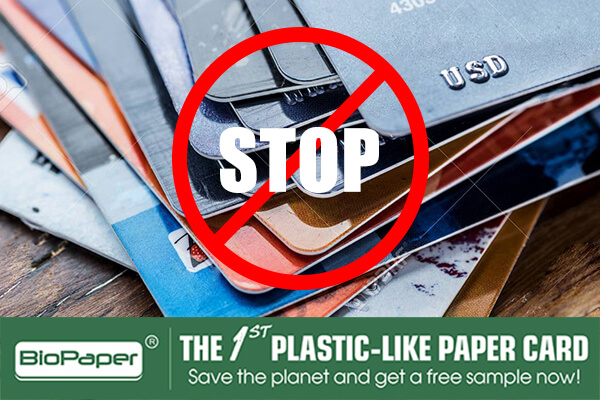Many credit cards are made of plastic that usually consists of PVC (polyvinyl chloride). This material consists of about 60% chlorine and 40% petroleum. Plastic cards are dense, water-resistant, and sturdy. They produce a high-quality print finish. Chip cards, RFID cards, hybrid cards, magnetic stripe cards, hotel key cards, and barcode cards are the most common types of plastic cards. Plastic cards are used for identification, membership cards, credit/debit cards, and access cards. They allow personalized payment tool that provides the ability to use the card. However, these plastic cards have some disadvantages which include;
Plastic cards are non-biodegradable
Even though the plastic card has expired, the material doesn’t. This means that plastic remains hazardous to the environment and it takes an average of 400 years to completely break down. To make the plastic cards, tons of PVC material are used annually. This means that the majority of them end up in the environment as plastic waste even though some may get recycled. Pigments and additives complicate the recycling process, therefore, to dispose of the plastic, it’s either dumped in landfills, incinerated, or finds its way into the oceans and rivers. Burning plastic releases harmful gases such as carbon monoxide, chlorine compounds, and dioxins which not only harm the environment but also cause diseases such as cancer. The plastics also emit hydrogen chloride (HCI) fumes when burnt which can pose severe health effects. With landfills, the toxic materials may end up flowing through rivers into the sea or leak slowly into the soil. Plastic cards have majorly contributed to dirty rivers.
Plastic cards are not durable
PVC material used to make plastic cards is an inexpensive, readily available material that can be printed on. Many businesses have opted for plastic cards to print the business’s logo, contact information, and address. However, PVC doesn’t stand up well when heated and it weakens causing it to either crack or break. Also when the plastic cards are exposed to a temperature of 20℉ they freeze and become hard, therefore, they can’t be used in cold temperatures. BioPaper cards can withstand both hot and cold temperatures because they have tear-resistant properties.
Plastic cards are not safe for the environment
Many businesses across the world are now embracing eco-friendly practices. Plastic cards are the most environmentally damaging plastics because they are made of PVC. From production, usage, and disposal of plastic cards lifecycle result in the release of chlorine-based chemicals which are toxic to both the environment and human beings. A high percentage of marine debris contains plastic. Non-profit agencies unite to clean up marine areas because the financial benefit is small.
Plastic cards are not recyclable
Plastics cannot be recycled once they reach their expiry date. They can be recovered a specific number of times before they lose their integrity and quality. Therefore, they can be down-cycled, that is, stashing them in a landfill or incinerating them. Plastic cards can’t be recycled at all like metal cards because of the properties of the material.
Plastic cards are harmful to all food chain organisms
When plastic waste flows into the oceans, they threaten aquatic life. Marine animals may be harmed or killed by plastic waste. Humans, animals, and plants may be damaged by plastic cards when they contaminate with harmful contaminants. From whales to tiny species such as planktons, plastic cards waste affects all food chain organisms.
Plastic cards contribute to economic losses
There is a global economic loss of approximately $80 billion annually caused by plastic pollution. Plastic cards are mostly used and have majorly contributed to this. Plastic cards aren’t beneficial to recycle, therefore, more of them tend to progress into waste streams alternately of reuse. On the other hand, BioPaper cards save the economy as they are produced from naturally derived raw materials.
Plastic cards are not safe for human use
Plastic cards are made from PVC which contains dangerous chemical additives like lead, cadmium, phthalates, and/or organotins that can be very harmful to human health. The inhalation or digestion of these chemical additives results in hormonal disruption in both males and females and also immune system damage. BioPaper cards are safe for human use because it’s made from naturally occurring sources.
Learn more about BioPaper here.

One Comment
[…] for identification and access control by many enterprises. But they are harmful to the environment. Click here to learn more about why we should stop using plastic […]
Comments are closed.